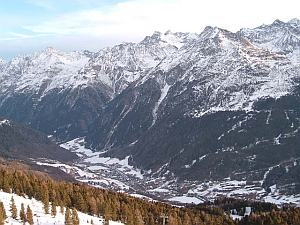
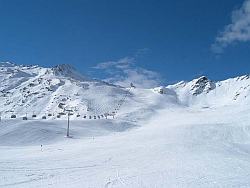 The village of Sölden is situated in the west of Austria, in the Tirol district, or to be more precise, in the Ötztal valley. With the population of 3000, it is the largest village in the valley. Also, Sölden is one of the largest, best equipped and most popular Austrian resorts, that ranks high in the world as well.
The village of Sölden is situated in the west of Austria, in the Tirol district, or to be more precise, in the Ötztal valley. With the population of 3000, it is the largest village in the valley. Also, Sölden is one of the largest, best equipped and most popular Austrian resorts, that ranks high in the world as well.
The resort spans at altitudes from 1350 to 3250 m, with its greatest part being situated at 2000 m above sea level. It consists of three connected parts: Gaislachkogl (up to 3041 m a.s.l.), Giggijoch (up to 3018 m a.s.l.), and a glacier part consisting of two glaciers - Rettenbach and Tiefenbach (up to 3249 m a.s.l.). The Rettenbach glacier plays host to opening WC giant events. In the last couple of years, it also hosts the World Snowboard Cup opener.
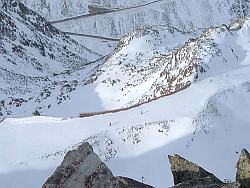 The resort has 146 km of ski runs, 51 km of which are classified blue, 62 km are red, and 27 km are black, and there are 6 km of "ski routes". The Gaislachkogl and Giggijoch ski runs are mostly reds and blues, which means they are not intended for beginners and ask for polished ski technique. However, they will certainly satisfy more experienced skiers seeking for demanding runs. The runs descending into the village of Sölden are rather 'awkward' due to their steepness. They are classified red and black and are not recommended for less experienced skiers, who will be much happier to descend to the valley in a gondola. Considering the fact that these two parts of the resorts are situated mostly above 2000 above sea level, the runs there are rather wide. There are no trees around, only rocks, which makes the setting similar to glacier.
The resort has 146 km of ski runs, 51 km of which are classified blue, 62 km are red, and 27 km are black, and there are 6 km of "ski routes". The Gaislachkogl and Giggijoch ski runs are mostly reds and blues, which means they are not intended for beginners and ask for polished ski technique. However, they will certainly satisfy more experienced skiers seeking for demanding runs. The runs descending into the village of Sölden are rather 'awkward' due to their steepness. They are classified red and black and are not recommended for less experienced skiers, who will be much happier to descend to the valley in a gondola. Considering the fact that these two parts of the resorts are situated mostly above 2000 above sea level, the runs there are rather wide. There are no trees around, only rocks, which makes the setting similar to glacier.
The runs on the Rettenbach glacier are mostly blues (the ones classified red also have elements of blues, author's remark), they are wide and of a relatively mild descent. Also, they are rather long for glacier runs and perfect for easy carving, and for skiers with less experience. However, the glacier is in winter accessible only through Giggijoch, which may pose problems for less experienced skiers. There is also an asphalt road leading to the glacier; weather allowing, the glacier runs are accessible by car or ski bus. The road passes through the highest tunnel in Europe ("Rosi Mittermeier Tunnel" at 3240 m a.s.l., author's remark). It is mostly closed in winter, due to a lot of snow, but you can use it from spring to late autmn.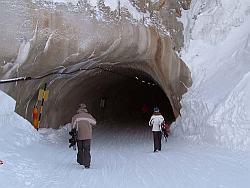 The Tiefenbach glacier runs are more fun for skiing. They are greater in number, wider and longer than those on the Rettenbach glacier. Run No.38 is definitely worth a mention; this wide and long slope is perfect for carving. The two glaciers are linked with a 150 m long ski tunnel under the mountain. They are connected with the rest of the resort (Giggijoch) by the "Golden gate to the glacier", a link comprised of two 4 seater lifts and a cabin lift, so you won't have to use a car or a bus.Unfortunately, the Gaislachkogl is not directly linked to the glaciers.
The Tiefenbach glacier runs are more fun for skiing. They are greater in number, wider and longer than those on the Rettenbach glacier. Run No.38 is definitely worth a mention; this wide and long slope is perfect for carving. The two glaciers are linked with a 150 m long ski tunnel under the mountain. They are connected with the rest of the resort (Giggijoch) by the "Golden gate to the glacier", a link comprised of two 4 seater lifts and a cabin lift, so you won't have to use a car or a bus.Unfortunately, the Gaislachkogl is not directly linked to the glaciers.
The runs are well marked, and orientation won't pose you any problems.Their length is estimated realistically. Some runs are really long, such as, for exapmle, the 12.8 km long run descending from the Schwarze Schneide peak to Sölden, with 1880 m vertical drop. descending down this run will tire out the legs of every skier and snowboarder. The non-glacier runs are hard packed and well prepared (a mixture of artificial and natural snow). The glacier runs softer, since they are prepared using only natural snow. Night skiing is possible on a 4 km long illuminated run.
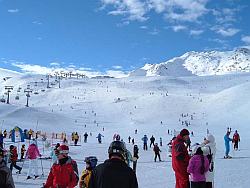 The runs on the rsort are covered by 34 ski lifts: 7 cabin lifts, three 6-seater lifts, nine 4-seater lifts, two 3-seater lifts, three 2-seater lifts, two 1-seater lifts and 8 surface lifts. Cabin lifts, 6-seater lifts and 4-seater lifts are modern and very fast; some have conveyor belts at the entrance, and most are hooded. Other slki lifts are of somewhat older date. However, much money is invested into the resort each year, and he old lifts are constantly being replaced by the new ones. Gaislachkogl and Giggijoch are equipped with mostly cabin and seater lifts, and glaciers are covered by cabin and surface lifts.
The runs on the rsort are covered by 34 ski lifts: 7 cabin lifts, three 6-seater lifts, nine 4-seater lifts, two 3-seater lifts, three 2-seater lifts, two 1-seater lifts and 8 surface lifts. Cabin lifts, 6-seater lifts and 4-seater lifts are modern and very fast; some have conveyor belts at the entrance, and most are hooded. Other slki lifts are of somewhat older date. However, much money is invested into the resort each year, and he old lifts are constantly being replaced by the new ones. Gaislachkogl and Giggijoch are equipped with mostly cabin and seater lifts, and glaciers are covered by cabin and surface lifts.
The resort has a capacity of almost 68000 skiers per hour, so the runs and ski lifts are almost never crowded. The only lifts that can get a bit crowdy are the cabin lifts at the foot of the resort, and it happens only in the morning when a great number of skiers set off to ski. The runs are accessible by Giggijochbahn and Gaislachkoglbahn cabin lifts located at the entrance and at the exit of Sölden. You can descent to the village by skiing down the five runs leading to the village, or by the one that will take you straight into its center.
The Sölden ski lift pass is among the most expensive ones in Austria. One day ski lifts pass in main season costs EUR 42.5, and six-day ski lift pass is EUR 212. In mid season, one day ski lift pass is EUR 41 and six-day ski lift pass costs EUR 190.5. You will get a key card pass for which pay EUR 2 deposit, or you can use a Swatch snow pass if you have the Swatch snowpass watch..
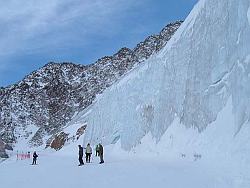 There are 23 restaurants on the resort, in which you can have a good rest from skiing. They are nice, large and decently equipped with deck chairs for sunbathing. Here are some of the prices: Cova Cola is EZR 2, spaghetti bolognese are EUR 7, pommes frites costs EUR 3, and the popular gulaschsuppe is around EUR 5.
There are 23 restaurants on the resort, in which you can have a good rest from skiing. They are nice, large and decently equipped with deck chairs for sunbathing. Here are some of the prices: Cova Cola is EZR 2, spaghetti bolognese are EUR 7, pommes frites costs EUR 3, and the popular gulaschsuppe is around EUR 5.
In case your ski equipment lets you down, don't worry. There are a couple of ski services within Intersport stores, located on both glaciers, at 3000 m a.s.l. The prices in "the mountain sports shops" are of course somewhat higher than in the village. There are two more things about the Rettenbach glacier that are worth a mention - "Europa Test & Exhibition Center" and "Salomon Station", where you can test the most eminent brands in the world of skiing.
There are some more attractions that make Sölden a well visited resort. It is one of the best Austrian resorts in terms of freeride and off-piste skiing. On condition there is enough snow, of course. Snow is, however, never lacking in higher altitudes. The lack of it occurs in lower altitudes during mild winters, but the runs are even then never closed due to diligence and hard work of the resort's stuff. It definitely explains the resort's slogan: "snow guarantee". Endless powder-making is accomplished with a snow-gun artillery that covers the area below 2200 m a.s.l. This season, almost all the Giggijoch runs (the area up to 2600 m a.s.l.), were covered by the snowmaking system.
The resort mostly advertises itself as the "BIG 3". There are three peaks higher that 3000 m above Sölden: Gaislachkogl (3058 m), Schwarze Schneid (3370 m) and Tiefenbachkogl (3.309 m). You can enjoy magnificent views of the surrounding peaks and glaciers from their lookout points. One of them, Gaislachkogl, even has a restaurant. When the weather is clear, these lookouts will award you with the view of the Italian Dolomites and the Swiss Alps.
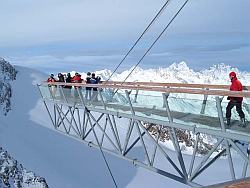 Those seeking for adventure have at their disposal a large snowpark with kickers, rails and 70 m high halfpipe at the Giggijoch, which is a magnet for boarders accross Europe. Besides, they also come here because the Giggijoch also has a great boardercross run. Also, there is a small snowpark on the Tiefenbach glacier. Of course, many come to take their chances at freeride boarding. Sölden is well known for its apres ski offer. Numerous discos and bars will keep you awake until the small hours. And, if you don't feel like walking back to your apartment after partying all night, you have a 24 h taxi service at your disposal.
Those seeking for adventure have at their disposal a large snowpark with kickers, rails and 70 m high halfpipe at the Giggijoch, which is a magnet for boarders accross Europe. Besides, they also come here because the Giggijoch also has a great boardercross run. Also, there is a small snowpark on the Tiefenbach glacier. Of course, many come to take their chances at freeride boarding. Sölden is well known for its apres ski offer. Numerous discos and bars will keep you awake until the small hours. And, if you don't feel like walking back to your apartment after partying all night, you have a 24 h taxi service at your disposal.
For those into nordic skiing, Sölden has in store10 kilometers of cross-country ski runs. Apart from skiing, you can also go hiking, take glacier walking tours, visit the ice cave under the Rettenbach glacier, go sledging, enjoy wellness and sauna treatments, play tennis or badminton, or go bowling.
Sölden is a rather expensive resort. The prices in stores, bars and restaurants are tailored for somewhat more deep pocketed customers which come mostly from Germany, Netherlands, Great Britain and Russia. Mixed goods stores are opened until 19:30 p.m. at the latest, and sports shops are moszly opened until 18:00 p.m..
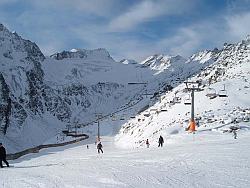 The accommodation is rather expensive, especially in main season. However, if you don't look for it in the centre of Sölden, (which is even better for true skiers, since they'll be closer to Giggijochbahn and Gaislahkoglbahn) you may be pleasantly surprised by the cheep prices. (Cheap in terms of Sölden, of course).
The accommodation is rather expensive, especially in main season. However, if you don't look for it in the centre of Sölden, (which is even better for true skiers, since they'll be closer to Giggijochbahn and Gaislahkoglbahn) you may be pleasantly surprised by the cheep prices. (Cheap in terms of Sölden, of course).
Above Sölden, at 2090 m of altitude, there is the Hochsölden hotel and appartment village. It is situated right at the slopes, and connected to Sölden by a road and 1-seater lift. You are guessing already , the accomodation prices there are higher that in Sölden. You can also look for accommodation in the neighbouring villages of Vent and Zwieselstein. The accommodation prices there are cheaper, and the villages are connected to Sölden by a ski bus. Apart from the villages of Vent and Zwieselstein, you can also consider the village of Längenfeld, which has a spa called Aqua Dome. There, you can relax in a number of thermal pools, saunas, whirpools and enjoy thermal water that wells out from the depth of 1865 m. Apart from Sölden, you can also ski in neighbouring Obergurgl and Hochgurgl, which can be included into your skilift pass.
The Sölden resort is deservedly one of the most popular European ski destinations. It should definitely be a must-visit for all snow junkies. The reason? Its numerous and well prepared ski runs, modern and fast ski lifts, beautiful freeride venues, and rich apres ski offer.
www.ski-mag.com
No comments:
Post a Comment